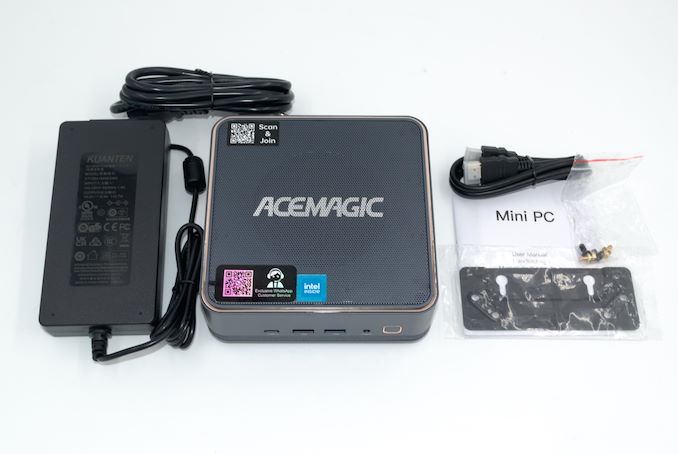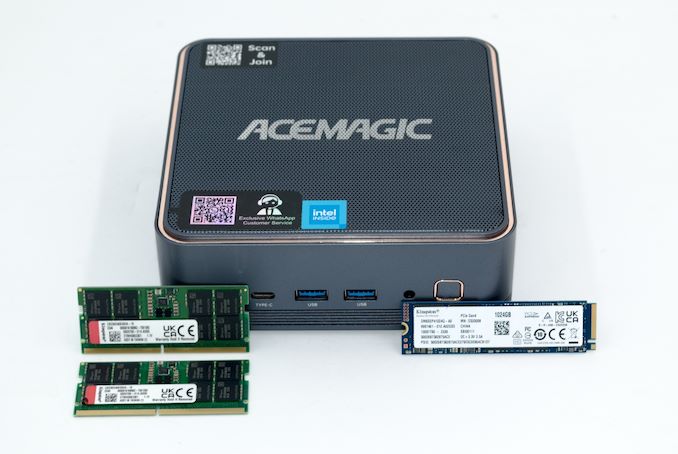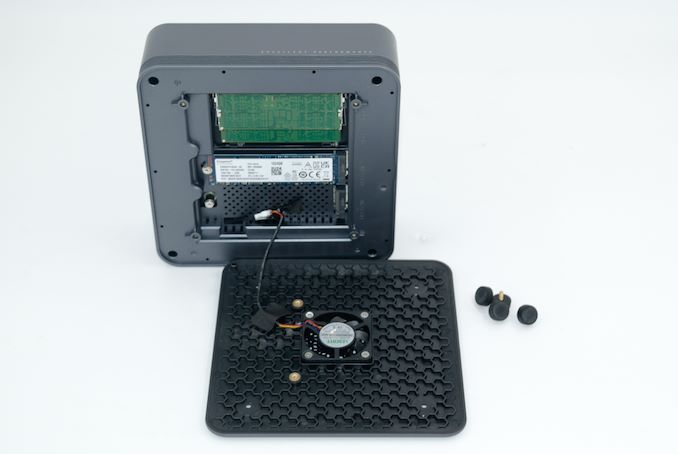ACEMAGIC F2A 125H SFF PC Review: Mid-Range Meteor Lake at 65W
by Ganesh T S on August 26, 2024 8:00 AM EST- Posted in
- Systems
- Intel
- SFF
- Mini-PC
- Meteor Lake
- AceMagician

Compact computing systems have gained significant market share over the last decade. Improvements in the performance per watt metric of processors have enabled the replacement of bulky desktop PCs by ultra-compact form-factor (UCFF) and small form-factor (SFF) machines. The Meteor Lake series of processors is the latest Intel offering to service this market. They have had a drawn-out launch since initial information was officially made available in September 2023. The tile-based chiplet configuration held together with Foveros packaging represented a major shift in Intel's approach to the consumer market, with notebook platforms being the primary focus. That has not prevented multiple vendors from introducing SFF / UCFF desktop systems using the Meteor Lake Ultra H-series (MTL-H) processors.
ACEMAGIC sampled us their F2A 125H offering around the time we were completing the evaluation of the ASRock Industrial NUC BOX-155H and the ASUS NUC14RVHv7 UCFF systems. The F2A is has a larger physical footprint compared to either of those systems. This allows for a better thermal solution, enabling the internal processor (Core Ultra 5 125H) to be operated with a sustained power limit (PL1) setting of 65W.
This review takes a detailed look at the features and performance profile of the ACEMAGIC F2A 125H. The analysis also provides some insights into the optimal operating power setting for the MTL-H processors.
Introduction and Product Impressions
The last decade has seen significant strides in processor performance as well as power efficiency. Coupled with advancements in thermal solutions, we have seen compact systems with low-power SoCs becoming capable of replacing bulky desktops for many use-cases. This trend gained mainstream attention with Intel's introduction of the ultra-compact form-factor (4in. x 4in.) NUC in the early 2010s.
In recent years, we have seen a steady progression in the power envelop of the processors getting integrated into such systems. The first generation NUCs had processors with a TDP between 6W and 15W. In the late 2010s, 28W processors formed the flagship lineups. With Tiger Lake, Intel introduced the Panther Canyon NUCs with a 40W limit. 65W has proved almost impossible to cool within UCFF constraints - and that has prompted ASUS to introduce the NUC14 Pro+ with a slightly larger footprint. ACEMAGIC's F2A also operates the processor at 65W albeit with a footprint even larger than that of the NUC14 Pro+.
The F2A system comes in at 147 mm x 147 mm x 52 mm (compared to the 144 mm x 112 mm x 41 mm of the NUC14 Pro+ and 117 mm x 112 mm x 54 mm of the tall 4"x4" NUC14 Pro). The promotion for the PC's AI features is heavy in the external package as well as the marketing collateral. The package contents include a 120W (19V @ 6.3A) power adapter, a geo-specific power cord, a HDMI cable, an user manual, and a mounting plate with screws in addition to the main unit.
ACEMAGIC sells the F2A as a ready-to-use system with 32 GB of DDR5-5600 SODIMMs and a 1 TB PCIe 4.0 x4 NVMe SSD. Windows 11 Home is pre-installed on the system. We always advise users of systems from vendors such as ACEMAGIC to wipe the drive and install their own copy of the OS after getting the key from the original installation.
Our sample was equipped with Kingston SODIMMs and a Kingston Design-In OEM SSD (BiCS5 TLC NAND behind a Silicon Motion SM2267XT DRAM-less controller).
Access to the SSD and SODIMM slots is obtained by removing four screws from the underside of the system. We were pleasantly surprised to find a fan attached to the underside. Active cooling for the SSD and SODIMMs ought to result in good thermal performance, and that is one of the aspects evaluated further down in this review.
The full specifications of the review sample are provided in the table below.
| ACEMAGIC F2A 125H Specifications (as tested) |
|
| Processor | Intel Core Ultra 5 125H Meteor Lake-H 4P + 8E + 2LPE / 18T, up to 4.5 GHz (P) up to 3.6 GHz (E) up to 2.5 GHz (LPE) Intel 4 (CPU) / TSMC N5 (iGPU), 18MB L2, Min / Max / Base TDP: 20W / 115W / 28W PL1 = 65W, PL2 = 90W |
| Memory | Kingston CBD56S46BS8HA-16 DDR5-5600 SODIMMs 46-45-45-90 @ 5600 MHz 2x16 GB |
| Graphics | Intel Arc Graphics (7 Xe-cores @ up to 2.2 GHz) |
| Disk Drive(s) | Kingston Design-In SSD OM8SEP41024Q-A0 (1 TB; M.2 2280 PCIe 4.0 x4 NVMe;) (Kioxia BiCS5 (112L) 3D TLC; Silicon Motion SM2267XT DRAM-less SSD Controller) |
| Networking | 1x 2.5 GbE RJ-45 (Realtek RTL8125) Intel Wi-Fi 7 BE200 (2x2 802.11be - 5.8 Gbps) |
| Audio | Conexant SN6140 (3.5mm Audio Jack in Front) Digital Audio with Bitstreaming Support over HDMI and Display Port (Type-C) |
| Video | 2x HDMI 2.0 (Rear) 1x DisplayPort 1.4 over Type-C Alt-Mode (Front / USB 3.2 Gen 2) |
| Miscellaneous I/O Ports | 2x USB 3.2 Gen 1 Type-A (Front) 1x USB 3.2 Gen 2 Type-C (Front, with DP Alt Mode) 2x USB 3.2 Gen 1 Type-A (Rear) |
| Operating System | Windows 11 Enterprise (22631.3593) |
| Pricing | $699 (Amazon) $569 (ACEMAGIC Storefront) (as configured, with Win 11 Home) |
| Full Specifications | ACEMAGIC F2A 125H Specifications |
In the next section, we take a look at the system setup and follow it up with a detailed platform analysis.













11 Comments
View All Comments
meacupla - Monday, August 26, 2024 - link
It is amazing what a few extra cm of space does for the thermals.Bonus points for 2x2280 storage, but I wish it supported 3x2280 or 2x22110
AdrianBc - Tuesday, August 27, 2024 - link
I agree with you, which is why I have liked a NUC-like computer with Ryzen AI 3xx that is expected to be launched in October and for whom some preliminary tests of a prototype have been shown on Youtube and linked on various sites with computer news.That computer has 3 M.2 2280 sockets, replacing the traditional NUC configuration with 1 M.2 2280 socket + 2 SODIMM sockets.
This was possible because the SODIMM sockets were replaced with faster soldered LPDDRX memory, selectable as 16 GB, 32 GB or 64 GB.
I have been using a lot of NUC-like computers for many years, and in my opinion for such computers it is far more useful to be able to install three full-size SSDs, than to be able to replace the DRAM. Therefore I approve the choice made by the designers of that computer.
Hulk - Monday, August 26, 2024 - link
If it is running 4.5GHz during CB R23 ST then that result it horrendous. Like 20% lower IPC-wise (throughput) than a similarly clocked Raptor Cove core.Techie4Us - Monday, August 26, 2024 - link
Design, features & thermals good, low-tier ram & dram-less SSD.....not so much, especially at this price point....If they offered a barebones unit for like ~$400, I might be interested, otherwise..pass....
Also the spec sheet says " OS = W11 Enterprise", then the pricing part right under that says "W11 HOME"... so which is it and how much difference does this make in the price ?
ganeshts - Tuesday, August 27, 2024 - link
ACEMAGIC sells the system with Win 11 Home pre-installed.However, when we test mini-PCs, we always wipe and install Windows 11 Enterprise. It just gives us more features to customize the behavior and prevent surprises while benchmarking.
The pricing includes the license for Win 11 Home (and that is why the mention of the Home variant is in the Pricing entry).
meacupla - Tuesday, August 27, 2024 - link
IDK what you consider "high-tier ram", but DDR5 SODIMM maxes out at 5600.eastcoast_pete - Monday, August 26, 2024 - link
Ganesh's advice about wiping the drive and do a complete new install of the OS before usw is, unfortunately, spot on. Other sites and reviewers had found potential malware / spyware on at least one Acemagic mini-PC they evaluated. Acemagic did respond very quickly and tried to explain it away, but Ganesh is 100% correct in pointing out that wiping the drive and a fresh reinstall of the OS is the safe thing to do.haplo602 - Tuesday, August 27, 2024 - link
Why would anybody buy Intel based miniPCs is beyond my understanding. Unless you need Quicksync the AMD based ones are overall better.nandnandnand - Tuesday, August 27, 2024 - link
Meteor Lake-H has improved integrated graphics considerably. But it all comes down to price in the end.haplo602 - Wednesday, August 28, 2024 - link
Given what I have seen with the MSI Claw, it also has terrible power management/distribution between the CPU anf GPU ...